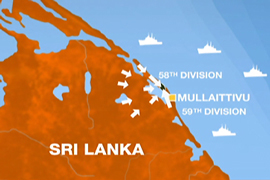Sri Lanka ‘cements’ LTTE defeat
Government says all civilians have been allowed out of the conflict zone as fighting continues.

“I am proud to announce … that my government, with the total commitment of our armed forces, has, in an unprecedented humanitarian operation, finally defeated the LTTE,” he told a summit in Jordan.
He returned to the capital, Colombo, on Sunday to street celebrations.
The Tamil Tigers on Sunday conceded their war with the government had reached its “bitter end” and said they had decided to “silence their guns”.
“This battle has reached its bitter end,” said Selvarajah Pathmanathan in statement on TamilNet, the pro-rebel website.
“We remain with one last choice – to remove the last weak excuse of the enemy for killing our people. We have decided to silence our guns.”
Civilian rescue
Despite the claim of victory, the whereabouts of Velupillai Prabhakaran, the leader of Tigers, remain unknown, and hundreds of thousands of civilians are still either on the move or in camps for the internally displaced.
| Focus: Sri Lanka | ||||||

|
The Sri Lankan ministry of disaster management and human rights said on Sunday it was continuing to process civilians rescued from the fighting.
Rajiva Wijesinha, a secretary at the ministry, told Al Jazeera from Colombo: “We heard that the last of them [civilians] had been saved. This was one of our great priorities in the last couple of weeks to make sure we got the civilians safely away.”
Amin Awad, a UNHCR representative in Sri Lanka, told Al Jazeera “almost all the population in the conflict zone, which has now shrank to less than one sq km, up to 60,000 people” had left.
He said they were being “processed at the Omanthai crossing point. That leaves very few, if any, people in the conflict zone”.
Both the government and the Tamil Tigers have been criticised for not allowing civilians safe exit from the area and for precipitating a humanitarian disaster.
Wijesinha said that just over 30,000 people had left the area of fighting over the past few days.
“These are our people. We were committed to their safety and I think we have achieved it much more sensibly and carefully than any other country in the world could have done,” he said.
“We managed to airlift 12 or 14 people who had been injured. I believe some of the younger members of the Tamil Tigers just refused to listen to the disgusting orders of their seniors.”
The Tamil Tigers had been fighting for more than 25 years for a homeland for ethnic Tamils in the north and east of the country, arguing that they were marginalised by the ruling majority Sinhalese government.
James Elder, a spokesman for Unicef, told Al Jazeera that civilians were arriving “sick and hungry” and that women and children were malnourished.
“This latest massive influx of people who have endured those extreme conditions is going to put even greater strain on those camps,” he said.
‘Non-combatants’
“These camps are being created by the government, which argues they are on the basis of state security and the time needed for mines to be cleared before resettlement can occur.
 |
| A Sri Lankan man waves his national flag as he celebrates in the capital [Reuters] |
“At the same time, it is urgent that the government comes out with very clear screening and separation policies and a timeline so those who are termed non-combatants are allowed freedom of movement and are allowed to resettle.”
Government forces continue to hunt for Prabhakaran and his deputies, but it is unclear if they have already fled overseas.
Defence officials told news agencies that sporadic fighting was continuing in a number of pockets across the small strip of land in the northeast of the country.
Reports are impossible to independently verify as the government has barred most journalists and aid workers from the conflict zone.
Jan Jananayagam, from a group called Tamils Against Genocide who has spoken to the LTTE, told Al Jazeera: “The Tamil Tigers have called for international intervention.
“They have said they are willing to co-operate with the UN and America. They do so because the people are suffering in the most enormous way,” she said.
Palitha Kohona, secretary of the Sri Lankan ministry of foreign affairs, told Al Jazeera that though the Tamil Tigers had been “defeated comprehensively”, achieving peace would take longer.
“You don’t have peace the day after winning the war,” he said.
‘Time and effort’
“It takes time … patience … effort. The Sri Lankan government and people who have endured the nightmare of the LTTE’s terrorism have all of those in plenty. I am very confident we will win the peace.”
 |
About 200,000 civilians have escaped the war zone in recent months and are being held in crowded displacement camps.
The International Committee of the Red Cross (ICRC) warned that there still remains the possibility of “an unimaginable humanitarian catastrophe” for the hundreds of wounded.
“No humanitarian organisation can help them in the current circumstances. People are left to their own devices,” Pierre Krahenbuhl, the ICRC’s director of operations, said.
Up to 7,000 civilians were killed and 16,700 wounded in the fighting from January 20 until May 7, according to a UN document given to The Associated Press by a senior diplomat.
Since then, doctors in the war zone say that more than 1,000 civilians have been killed in a week of heavy shelling that rights groups and foreign governments have blamed on Sri Lankan forces.
